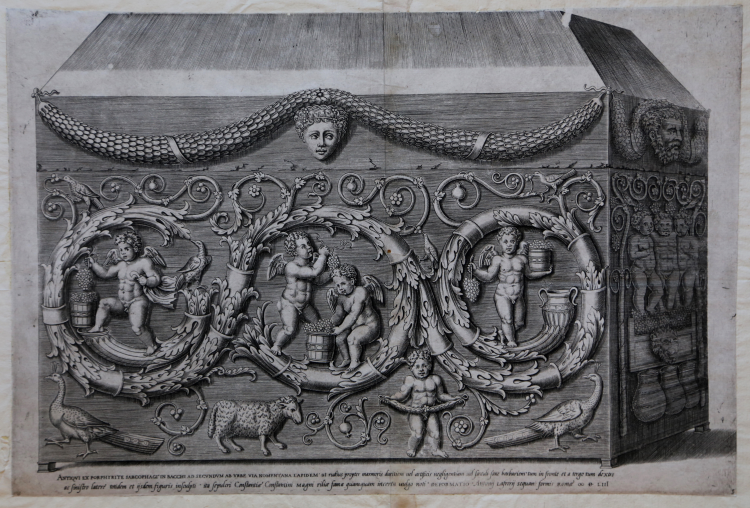




| Reference: | S32264 |
| Author | Antonio LAFRERI |
| Year: | 1553 |
| Measures: | 422 x 280 mm |



| Reference: | S32264 |
| Author | Antonio LAFRERI |
| Year: | 1553 |
| Measures: | 422 x 280 mm |
Engraving, 1553, signed and dated at lower right.
Example of the first state of four, with the Lafreri's imprint.
A fine impression, printed on contemporary laid paper, trimmed to the platemark and laid down on antique paper, a light abrasion at the upper edge, otherwise, very good condition.
The porphyry sarcophagus «of Constantine», daughter of Constantine, is represented and dates back to 340 AD. Renaissance scholars believed it was dedicated to Bacchus for the harvest scenes depicted on all four sides. However, the relief lends itself to a double reading: pagan, referable precisely to the Dionysian cult, and Christian for the symbolic value of wine as the blood of Christ. The urn underwent several transfers. Originally in the Mausoleum of Constance, throughout the Middle Ages it remained in the church of Santa Costanza. In 1467 it was moved to Piazza San Marco "A of August 14, that ark of rough porphyry that was burial of Santa Costanza" came to Piazza di San Marco ", and then finally landed in the Vatican in 1790. Today the sarcophagus is exhibited in the Pio Clementino Museum.
In 1540 Antonio Lafreri, a native of Besançon transplanted to Rome, began publishing maps and other printed images that depicted major monuments and antiquities in Rome. These images were calculated to appeal to the taste for classical antiquity that fueled the cultural event we call the Renaissance. After Lafreri published a title page in the mid-1570s, collections of these prints came to be known as the Speculum Romanae Magnificentiae, the "Mirror of Roman Magnificence." Tourists and other collectors who bought prints from Lafreri made their own selections and had them individually bound. Over time, Lafreri's title page served as starting point for large and eclectic compilations, expanded and rearranged by generations of collectors.
|
Hülsen 1921, Nr. 43; Corsi/Ragionieri 2004, S. 27, Nr. 15; Alberti n. 63, I/III; Rubach 105, I/IV; C. L. Witcombe, Print Publishing in Sixteenth-Century Rome, p. 140, 3.33.
|
Antonio LAFRERI (Orgelet 1512 - Roma 1577)
|
An engraver, publisher and dealer in prints and books. He moved in Rome about 1544, and began a series of joint ventures with the older Roman publisher Antonio Salamanca that continued until the latter's death in 1562. Lafrery in best known for prints showing the architecture and sculpture of ancient Rome. He commissioned a title page Speculum Romanae Magnificentiae, engraved by E. Duperac in 1573, to enable the buyer to compile his own collection from Lafrery's stock. Similarly realized collections of maps, different in the number and type of maps included with the title Geografia/Tavole moderne di geografia/de la maggior parte del mondo/di diversi autori/raccolte et messe secondo l’ordine/di Tolomeo/con i disegni di molte città et/fortezze di diverse provintie/stampate in rame con studio et diligenza/in Roma, known as Atlanti Lafrery. Besides the Speculum, Lafrery published two title pages for collections of religious subjects.
|
|
Hülsen 1921, Nr. 43; Corsi/Ragionieri 2004, S. 27, Nr. 15; Alberti n. 63, I/III; Rubach 105, I/IV; C. L. Witcombe, Print Publishing in Sixteenth-Century Rome, p. 140, 3.33.
|
Antonio LAFRERI (Orgelet 1512 - Roma 1577)
|
An engraver, publisher and dealer in prints and books. He moved in Rome about 1544, and began a series of joint ventures with the older Roman publisher Antonio Salamanca that continued until the latter's death in 1562. Lafrery in best known for prints showing the architecture and sculpture of ancient Rome. He commissioned a title page Speculum Romanae Magnificentiae, engraved by E. Duperac in 1573, to enable the buyer to compile his own collection from Lafrery's stock. Similarly realized collections of maps, different in the number and type of maps included with the title Geografia/Tavole moderne di geografia/de la maggior parte del mondo/di diversi autori/raccolte et messe secondo l’ordine/di Tolomeo/con i disegni di molte città et/fortezze di diverse provintie/stampate in rame con studio et diligenza/in Roma, known as Atlanti Lafrery. Besides the Speculum, Lafrery published two title pages for collections of religious subjects.
|